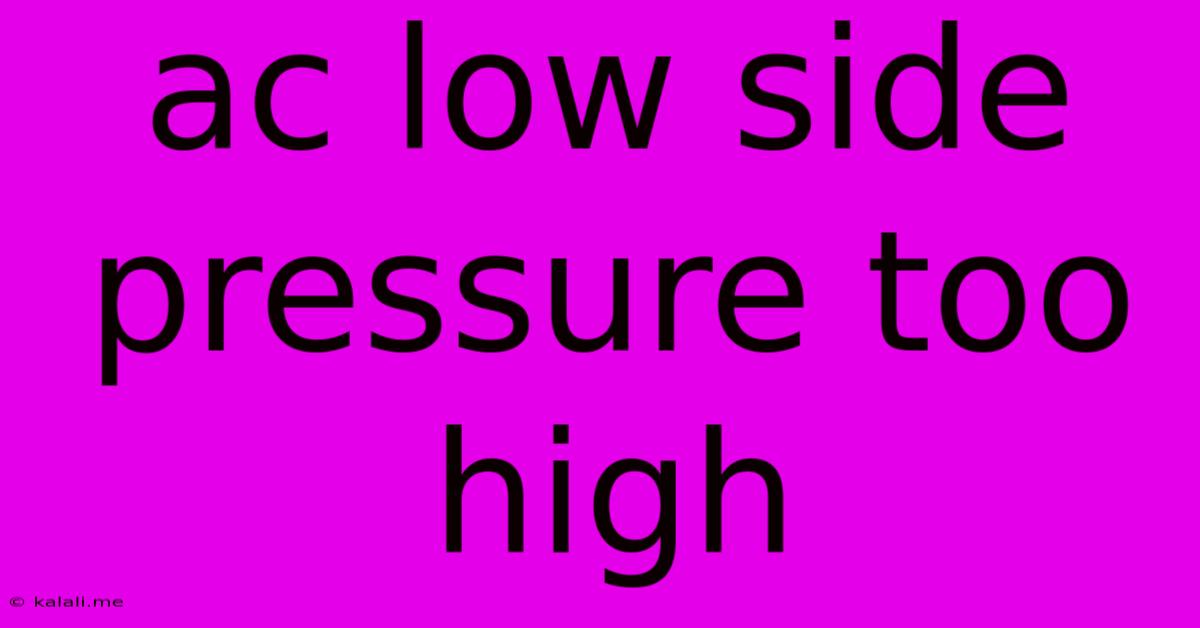Ac Low Side Pressure Too High
Kalali
May 30, 2025 · 4 min read

Table of Contents
AC Low Side Pressure Too High: Troubleshooting and Solutions
Meta Description: Experiencing high low-side AC pressure? This comprehensive guide explores common causes, troubleshooting steps, and solutions for this perplexing automotive air conditioning problem. Learn how to diagnose and fix a high low-side pressure issue effectively.
High low-side AC pressure is a common problem that can leave your car's air conditioning system struggling to cool effectively, or even completely inoperable. Unlike a low low-side pressure, which usually points to refrigerant leaks, a high pressure reading suggests a different set of underlying issues. This article will guide you through the potential culprits, troubleshooting steps, and solutions to get your AC blowing cold again.
Understanding AC System Pressure
Before diving into the troubleshooting, it's crucial to understand the basics of AC system pressure. Your car's air conditioning system operates on a delicate balance of high and low pressures. The low-side pressure represents the refrigerant's pressure before it enters the compressor, while the high-side pressure indicates the pressure after the compressor. A high low-side pressure indicates a problem that is preventing the refrigerant from flowing correctly through the system.
Common Causes of High Low-Side AC Pressure
Several factors can contribute to high low-side pressure in your vehicle's AC system. These include:
-
Restricted Refrigerant Flow: This is often the most common cause. Blockages in the system, such as a clogged expansion valve, orifice tube, or condenser, can prevent the refrigerant from flowing smoothly, leading to a pressure buildup on the low side. These components are vital for regulating refrigerant flow and pressure.
-
Compressor Problems: A faulty compressor can either fail to pump refrigerant effectively or even pump it in the wrong direction, leading to increased low-side pressure. This includes issues like a seized compressor clutch or internal compressor damage.
-
System Overcharge: Adding too much refrigerant to the system can also lead to excessive pressure. This is a relatively easy mistake to make during recharging, highlighting the importance of precise refrigerant measurements.
-
Faulty Pressure Switch: The pressure switch is a safety device that monitors the system's pressure and can activate or deactivate the compressor. A malfunctioning pressure switch might not shut off the compressor, even with high pressure, further exacerbating the issue.
-
Condenser Issues: While a restricted condenser usually affects high-side pressure, severe restrictions can affect both sides, leading to a pressure buildup on the low side.
Troubleshooting Steps for High Low-Side AC Pressure
Troubleshooting requires a systematic approach. Here's a step-by-step guide:
-
Check Refrigerant Levels: While unlikely to be the cause of high pressure, double-check that the system isn't significantly overcharged. Incorrect refrigerant levels can affect the entire system's performance.
-
Inspect for Leaks: Though more associated with low pressure, a small leak can sometimes influence pressure readings. Carefully inspect all lines and components for any signs of leaks.
-
Verify Compressor Operation: Ensure the compressor clutch engages and disengages correctly. Listen for unusual noises, and check the compressor's operation using a pressure gauge.
-
Check the Expansion Valve/Orifice Tube: These are critical components; blockages can significantly impact pressure. Their condition needs careful inspection, possibly requiring professional evaluation and replacement.
-
Examine the Condenser: Inspect for any obstructions, bends, or damage that might restrict airflow. A dirty condenser can reduce efficiency and contribute to pressure issues.
Solutions and Repairs
The solution directly depends on the identified problem. Repairing or replacing the faulty component is usually necessary:
-
Replace a clogged expansion valve or orifice tube: This often requires specialized tools and knowledge.
-
Repair or replace a faulty compressor: Compressor replacement is a significant repair, usually requiring professional assistance.
-
Evacuate and recharge the system: If the system is overcharged, removing excess refrigerant will restore proper pressure.
-
Repair or replace a faulty pressure switch: This usually involves a relatively straightforward replacement.
-
Clean or replace the condenser: A dirty condenser can be cleaned, but severe damage may necessitate replacement.
Conclusion:
Addressing high low-side AC pressure requires careful diagnosis and potentially professional intervention. Understanding the potential causes, diligently following troubleshooting steps, and seeking professional help when needed will ensure your car's AC system is functioning correctly and efficiently, keeping you cool and comfortable. Remember to always prioritize safety when working with refrigerant and automotive systems.
Latest Posts
Latest Posts
-
How To Find A Vector Perpendicular
May 31, 2025
-
How To Normalize Data Between 0 And 1
May 31, 2025
-
How Long Does Gas Stay Good In A Gas Can
May 31, 2025
-
How To Remove A Silicone Sealant
May 31, 2025
-
Bathroom Exhaust Fan Not Pulling Air
May 31, 2025
Related Post
Thank you for visiting our website which covers about Ac Low Side Pressure Too High . We hope the information provided has been useful to you. Feel free to contact us if you have any questions or need further assistance. See you next time and don't miss to bookmark.